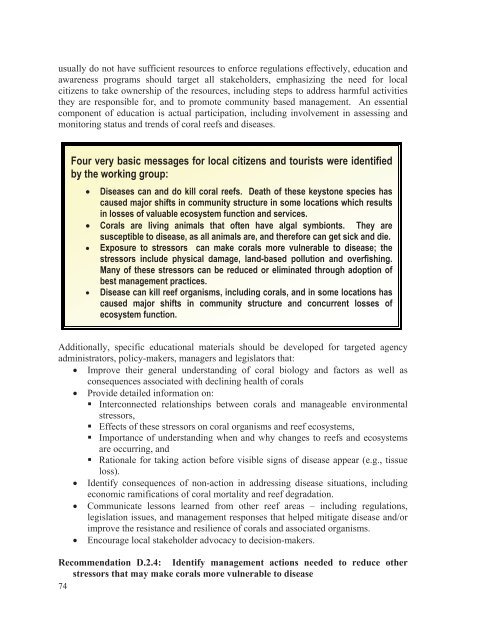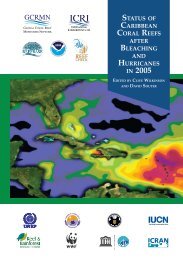Coral Health and Disease in the Pacific: Vision for Action
Coral Health and Disease in the Pacific: Vision for Action
Coral Health and Disease in the Pacific: Vision for Action
Create successful ePaper yourself
Turn your PDF publications into a flip-book with our unique Google optimized e-Paper software.
usually do not have sufficient resources to en<strong>for</strong>ce regulations effectively, education <strong>and</strong>awareness programs should target all stakeholders, emphasiz<strong>in</strong>g <strong>the</strong> need <strong>for</strong> localcitizens to take ownership of <strong>the</strong> resources, <strong>in</strong>clud<strong>in</strong>g steps to address harmful activities<strong>the</strong>y are responsible <strong>for</strong>, <strong>and</strong> to promote community based management. An essentialcomponent of education is actual participation, <strong>in</strong>clud<strong>in</strong>g <strong>in</strong>volvement <strong>in</strong> assess<strong>in</strong>g <strong>and</strong>monitor<strong>in</strong>g status <strong>and</strong> trends of coral reefs <strong>and</strong> diseases.Four very basic messages <strong>for</strong> local citizens <strong>and</strong> tourists were identifiedby <strong>the</strong> work<strong>in</strong>g group:<strong>Disease</strong>s can <strong>and</strong> do kill coral reefs. Death of <strong>the</strong>se keystone species hascaused major shifts <strong>in</strong> community structure <strong>in</strong> some locations which results<strong>in</strong> losses of valuable ecosystem function <strong>and</strong> services.<strong>Coral</strong>s are liv<strong>in</strong>g animals that often have algal symbionts. They aresusceptible to disease, as all animals are, <strong>and</strong> <strong>the</strong>re<strong>for</strong>e can get sick <strong>and</strong> die.Exposure to stressors can make corals more vulnerable to disease; <strong>the</strong>stressors <strong>in</strong>clude physical damage, l<strong>and</strong>-based pollution <strong>and</strong> overfish<strong>in</strong>g.Many of <strong>the</strong>se stressors can be reduced or elim<strong>in</strong>ated through adoption ofbest management practices.<strong>Disease</strong> can kill reef organisms, <strong>in</strong>clud<strong>in</strong>g corals, <strong>and</strong> <strong>in</strong> some locations hascaused major shifts <strong>in</strong> community structure <strong>and</strong> concurrent losses ofecosystem function.Additionally, specific educational materials should be developed <strong>for</strong> targeted agencyadm<strong>in</strong>istrators, policy-makers, managers <strong>and</strong> legislators that: Improve <strong>the</strong>ir general underst<strong>and</strong><strong>in</strong>g of coral biology <strong>and</strong> factors as well asconsequences associated with decl<strong>in</strong><strong>in</strong>g health of corals Provide detailed <strong>in</strong><strong>for</strong>mation on: Interconnected relationships between corals <strong>and</strong> manageable environmentalstressors, Effects of <strong>the</strong>se stressors on coral organisms <strong>and</strong> reef ecosystems, Importance of underst<strong>and</strong><strong>in</strong>g when <strong>and</strong> why changes to reefs <strong>and</strong> ecosystemsare occurr<strong>in</strong>g, <strong>and</strong> Rationale <strong>for</strong> tak<strong>in</strong>g action be<strong>for</strong>e visible signs of disease appear (e.g., tissueloss). Identify consequences of non-action <strong>in</strong> address<strong>in</strong>g disease situations, <strong>in</strong>clud<strong>in</strong>geconomic ramifications of coral mortality <strong>and</strong> reef degradation. Communicate lessons learned from o<strong>the</strong>r reef areas – <strong>in</strong>clud<strong>in</strong>g regulations,legislation issues, <strong>and</strong> management responses that helped mitigate disease <strong>and</strong>/orimprove <strong>the</strong> resistance <strong>and</strong> resilience of corals <strong>and</strong> associated organisms. Encourage local stakeholder advocacy to decision-makers.Recommendation D.2.4: Identify management actions needed to reduce o<strong>the</strong>rstressors that may make corals more vulnerable to disease74
















